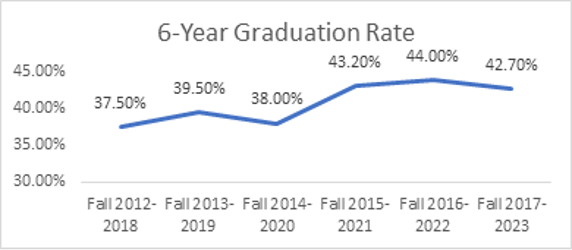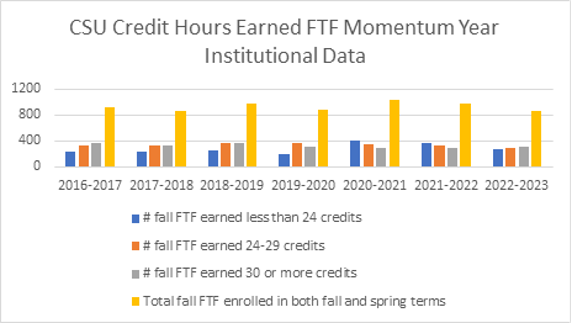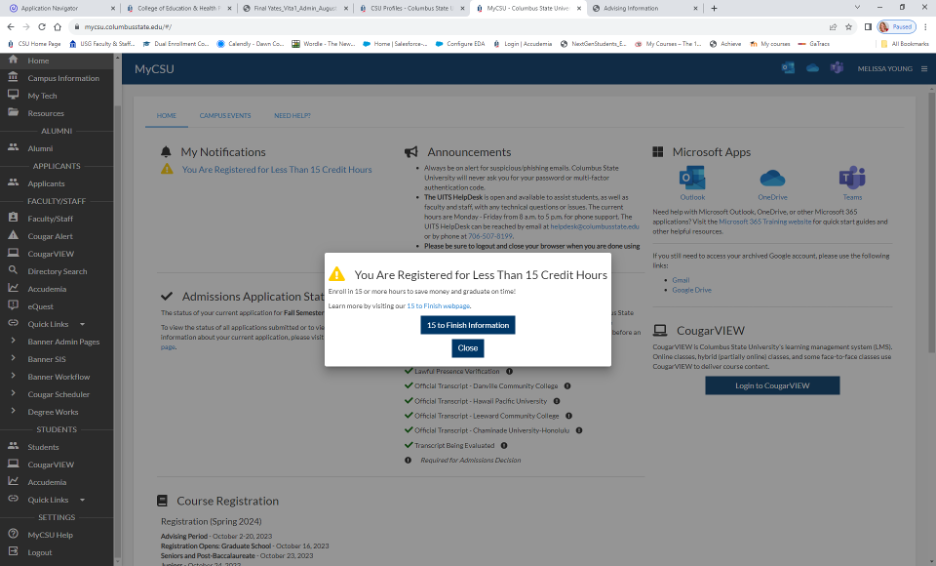Columbus State University (CSU) is a public (state-supported) institution that offers 114 programs at the certificate, associate, bachelor’s, master’s, specialist, and doctoral levels. Many degrees are conferred in professional areas at both undergraduate and graduate levels in response to student demand and service area needs. Due to the nature of Complete College Georgia, this report only concerns our undergraduate degree programs and primarily focuses on efforts and strategies aimed at student success that align with our Momentum Approach Implementation Plan and Calendar as well as our commitment to the standards of the National Institute for Student Success (NISS).
Institutional Mission
While CSU’s vision is to “provide world-class education and assure student success through creative inquiry and community, regional, and global partnerships,” its mission is
- “To achieve academic excellence through teaching, research, creative inquiry and student engagement.
- To achieve excellence in the student experience and prepare individuals for a life of success, leadership, and responsibility through community awareness, engagement, and service to others.
- To achieve recognition as a leader in community development, regional economic development, and public-private partnerships.”
The institutional focus on excellence in teaching and research as well as the emphasis on creative inquiry and student engagement influences the key priorities of the college completion work that CSU has undertaken. The university financially supports student research and creative inquiry projects facilitated by faculty mentors. It further celebrates student research and creative innovation through its annual Tower Day conference, usually held in late April. In addition, CSU has a strong commitment to student experience for it has provided significant leadership in meeting the needs of the community, the region, and the state through endeavors such as Dual Enrollment, service to military-affiliated students, and the development of high-quality online programs and services that allow students to decrease time to completion regardless of their geographic location and to continue their higher education in the age of COVID-19. Through its many service-oriented opportunities on campus and in the community, its local and regional internships, its study away courses, and its study abroad experiences, CSU excels in its mission to “achieve recognition as a leader in community development, regional economic development, and public-private partnerships” as well as its global imprint on the hearts and minds of students.
Student Body Profile
The University System of Georgia (USG) designates CSU as one of the three “access” institutions within the state because no State Colleges in the USG are located within the geographic service area. The service area of Columbus State University is defined as these Georgia counties: Chattahoochee, Harris, Marion, Meriwether, Muscogee, Stewart, Talbot, Taylor, and Troup. In Fall 2023, 54.0% of the new
student population was drawn from these counties. A breakdown of demographics for FYFT freshmen (such as 55.8% Pell recipient, 26.3% first-generation, 38.0% African American, etc.) is shown in Appendix I: CSU Demographics of FYFT Students (2023).
In a typical year, Columbus State University utilizes moderately selective admissions standards and processes for most applicants (high school grade point average of 2.5 and SAT minimum scores of 440 Critical Reading and 410 Math or ACT English 17/Math 17). In the past, modified standards were utilized for applicants within the local service area in accordance with the University System of Georgia-mandated local access mission (high school grade point average of 2.0 and SAT minimum scores of 330 Critical Reading and 310 Math or ACT English 12/Math 14).
Since the pandemic, CSU has temporarily revised requirements for all high school applicants to the University System of Georgia minimum requirements of high school GPA for state universities and not requiring ACT or SAT scores as entrance requirements. Beginning in Fall 2022, CSU received permission from the system to move forward with plans to develop a formal access mission pathway, which allows students in our local service area with a minimum 2.0 HS GPA the opportunity to be admitted to CSU in the Associate of Science in Core Curriculum (ASCC_AM). Students admitted via this pathway must remain in the associate degree program until they have successfully completed 30 semester hours and have the institutional GPA required to move into their intended baccalaureate programs. This population of students has a dedicated advisor who works with them on course planning and goal setting to ensure that their transition to and through college is successful.
In addition to supporting access mission students, CSU ADVISE has developed an intensive and proactive advising plan which targets all students who may be at risk. Learning Support Services are also essential to support academic and integrative needs of these populations. See Appendix II: Summary of Activities and Measures of Success for CSU ADVISE Intentional Activity Plan.
While CSU takes pride in its role as an access institution, this role presents challenges in retention and student success. Nonetheless, due to CSU best practices, retention and graduation rates had increased overall in the last eight years, until COVID-19 hit in 2020. The overall CSU retention rates, 2012-2020, for first-time full-time (FTFT) freshmen had increased from 66.2% to 74.9%, yielding an increase of 8.7% over eight years. Unfortunately, the FTFT retention rate for the 2020 cohort dipped to 59.4%, probably a result of a combination of factors, such as lower COVID admission standards, student fatigue with the continued impact of the global pandemic, student difficulty with online learning, and an increase in students who temporarily stayed home but who have now transferred out to their intended college. Fortunately, the 2021 cohort retention rate is 65.7%, an increase of 6.3% in one year, and our 2022 cohort retention rate of 72.2% only furthers our resolve that what we are doing is making a marked difference.
Not only has our retention rate increased overall, our 6-year institutional graduation rate has risen from 32.3% (Fall 2011-2017) to 42.7% (Fall 2017-2023), an increase of 10.4%. See pages 12-13 for details concerning our graduation rate and our dedication to 15-to-Finish.
For its 2023 CCG Campus Plan Update, CSU focused primarily (Section 2) on four activities/projects developed in Part 1 of the Momentum Summit VII report, activities/projects that emphasize student success:
- Structuring at least 3 HIPS into each baccalaureate program, beginning with 10 programs.
- Encouraging a growth Mindset in students.
- Scaling up Cougar Scholars & Cougar Launch.
- Tracking student engagement in and out of the classroom.
Because of important updates and/or scalable application, we have also chosen to include an optional section (Section 3: Optional Supplemental Updates) prior to Section 4: Observations and Next Steps.




